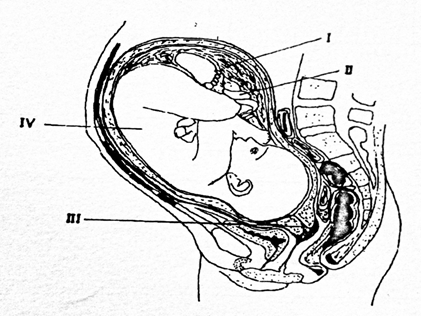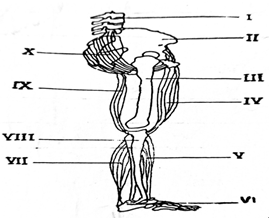Question 6
The diagram below illustrates a disease condition in humans. Study it and answer questions6(a) to 6(c).

(a) (i)Name the disease condition illustrated. [1 mark]
(ii) Mention one climatic condition that favours the spread of the disease condition named in 6(a)(i) [4 marks]
(iii) List three parts of the body that could be affected by the disease condition named in 6(a)(i).
[3 marks]
(b) Identify three objects that aid movement of persons affected by the disease condition. [3 marks]
(c) State two medical interventions that could prevent the occurrence of the disease. [2 marks]
The diagram below illustrates some parts of the human body. Study it and answer questions6(d) and 6(e).

(d) (i)Name the parts labelled II, III, V, VI, VII, VIII, IX and X. [4 marks]
(ii) Mention two major structures associated with the illustrated parts of the human body. [2 marks]
(e)(i)Namethree emergency conditions that could occur to the part labeled IV. [3 marks]
(ii) Stateone mineral found in the part labeled III. [1 mark]
Observation
Many candidates attempted this question and performed well in it. Many candidates could not correctly
answer Question 6(d)(i) Vital marks were however lost to poor spellings and articulation of answers.
The expected answers are:
(a)(i) Name of disease condition
Poliomyelitis/Polio/Infantile paralysis
(ii) Climatic condition that favours the spread of Poliomyelitis
Tropical/hot climate/weather
(iii) Parts of the body that could be affected by Poliomyelitis
- Legs/lower limbs
- Arms/upper limbs
- Brain/central nervous system
- Spinal cord/spine/backbone
- Muscle
(b) Objects that aid the movement of persons affected by Poliomyelitis
- Walking aid/crutches/named
- Orthoses/brace/leg brace
- Corrective Shoes/artificial limb
- Metal cast
- Wheel chair
(c) Medical interventions to prevent Poliomyelitis
- Immunization/vaccination
- Good nutrition/dieting
(d) (i)Name of labelled parts II,III,V,VI,VII,VIII,IX and X
II - Pelvis/pelvic bone/hip bone
III - Femur/thigh bone
V - Tibialis anterior/peroneus
VI - Ankle/anklejoint/tarsal bone
VII - Gastrocnemius/calf muscle
VIII - Tibia/shin bone
IX - Hamstrings/biceps femoris/named
X - Gluteus maximus/gluteal muscle
(ii) Structures associated with the illustrated part of the body
- Bones
- Muscles
(e) (i) Emergency condition that could occur to the part labelled IV/Quadriceps/named
- Muscle pull/cramps
- Muscle tear
- Cuts
- Burns
- Scalds
- Wounds/named
- Contusion/bruises
- Strain
(ii)Mineral found in Femur/III
- Calcium
- Phosphorus
